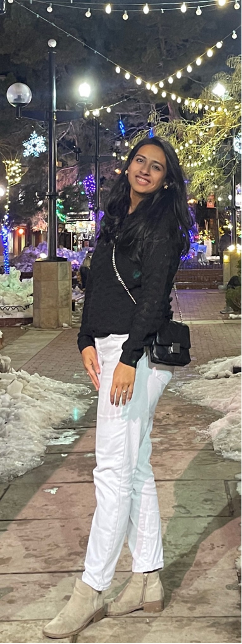
by Kamila Kinyon
This Fall, we will be publishing a series of spotlight articles about multilingual students at DU. These articles are based on interviews that Kamila Kinyon conducted about students’ memories of becoming multilingual, their connection to their heritage language, and their experiences at DU. This project is funded by a 4D Infusion Grant awarded for 2022-23 to Juli Parrish and Kamila Kinyon. We welcome this opportunity to celebrate DU’s multilingual speakers and writers.
Namrata Chatterjee, an international student from Kolkata, India, is working on a doctorate in the Department of Geography and the Environment. Trilingual in Bengali, Hindi, and English, she considers Bengali her native language. She has spoken Bengali with family since childhood but attended an English school in Kolkata where some of her friends spoke Hindi as a first language. Being trilingual from an early age, Namrata translates quickly from one language to another and is fluent in all three.
Especially since she was taught to write, read, and speak in English from a young age, Namrata generally finds it easy to shift from one language to another. In describing the process of translation between languages, Namrata says: “Sometimes a thought came to me which is related to my research…I still write it down in English…I won’t write it down in Bengali or Hindi. The translation sometimes happens…in my head in a very quick second. So sometimes I don’t register that I translated it right now.”
At DU, Namrata was able to connect with other international students through the International Student Orientation. She found friends within a larger community of international students from countries including the Ukraine, Africa, and her native country, India: “The first person I connected to was from India, from Kolkata, and she’s my roommate right now. We also found a lot of people who are from other parts like Delhi, Mumbai, Chennai. So there’s a community here at DU who are Indian, and they might not speak the same language…So our common language is English.” Namrata finds that the International Student Orientation is a very good session every year and during her second year she contributed to welcoming first-year international students to the university: “I was a panelist in the second-year session, because I had one year of experience living here.”
Namrata has also had the opportunity to connect with other multilingual students while teaching undergraduate geography courses at DU. For example, Namrata has found her multilingualism to be an advantage for her work as a TA in the Environmental Systems sequence. Her linguistic background gives her more understanding and empathy for multilingual students and for the process of translation that they go through when speaking or writing in English: “I understand because I’m also an international student. I get that they would need more time to communicate their thoughts. Everybody might not have the same level of fluency (in English). You think in a different language, you translate it and then write it. So I used to calm those students down. I used to tell them my story like, I’m from a different country, I speak a different language, I do the same.”
Namrata’s goals after finishing her doctorate are to work in the U.S. for one more year through an internship and to then return home to Kolkata to find employment. She has had a positive experience as an international student, and she encourages other students to also study abroad and to speak and learn other languages. She has found that American university culture welcomes different accents and styles of speaking: “Whatever accent you speak, however you speak, if you make sense, people will understand.”
In praising the values of multilingualism and of the international student experience, Namrata concludes: “I would say that it’s awesome when people can speak multiple languages. Some people are a little scared when they move to the U.S. speaking only in English, but…everyone sees their community after they come here and finds their own zone as well.”
